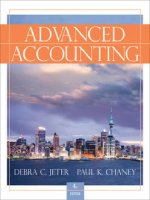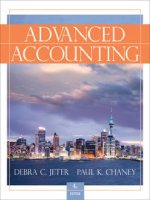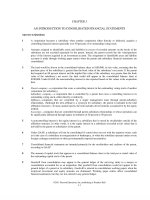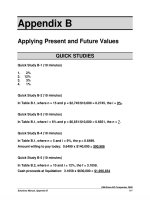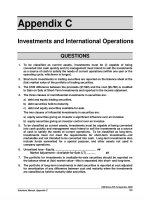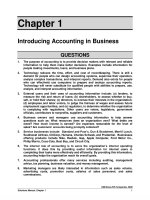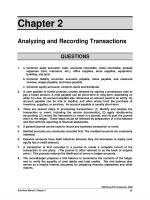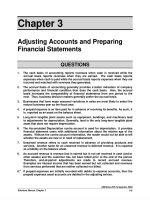Solution manual financial accounting 4e by wild chapter03
Bạn đang xem bản rút gọn của tài liệu. Xem và tải ngay bản đầy đủ của tài liệu tại đây (2.25 MB, 105 trang )
To download more slides, ebook, solutions and test bank, visit
Chapter 3
Adjusting Accounts and Preparing
Financial Statements
QUESTIONS
1.
The cash basis of accounting reports revenues when cash is received while the
accrual basis reports revenues when they are earned. The cash basis reports
expenses when cash is paid while the accrual basis reports expenses when they are
incurred and matched with revenues they generated.
2.
The accrual basis of accounting generally provides a better indication of company
performance and financial condition than does the cash basis. Also, the accrual
basis increases the comparability of financial statements from one period to the
next. Thus, business decision makers generally prefer the accrual basis.
3.
Businesses that have major seasonal variations in sales are most likely to select the
natural business year as the fiscal year.
4.
A prepaid expense is an item paid for in advance of receiving its benefits. As such, it
is reported as an asset on the balance sheet.
5.
Long-term tangible plant assets such as equipment, buildings, and machinery lead
to adjustments for depreciation. Generally, land is the only long-term tangible plant
asset that does not require depreciation.
6.
The Accumulated Depreciation contra account is used for depreciation. It provides
financial statement users with additional information about the relative age of the
assets. Without the contra account information, the reader would not be able to tell
whether the assets are new or in need of replacement.
7.
Unearned revenue refers to cash received in advance of providing products and
services. Another name for an unearned revenue is deferred revenue. It is reported
as a liability on the balance sheet.
8.
An accrued revenue is revenue that is earned but is not yet received in cash (and/or
other assets) and the customer has not been billed prior to the end of the period.
Therefore, end-of-period adjustments are made to record accrued revenue.
Examples are interest income that has been earned but not collected and revenues
from services performed that are neither collected nor billed.
9.A If prepaid expenses are initially recorded with debits to expense accounts, then the
prepaid expenses asset accounts are debited in the adjusting entries.
©McGraw-Hill Companies, 2008
Solutions Manual, Chapter 3
119
To download more slides, ebook, solutions and test bank, visit
10.
For Best Buy, all of the accounts under the category of Property and Equipment
(except for Land), require adjusting entries. The expense related to the depreciation
expense account would be understated on the income statement if Best Buy fails to
adjust these asset accounts. If the adjusting entries are not made, net income would
be overstated. Note: Students might also correctly identify accounts receivable,
goodwill, and tradename as needing adjustment.
11.
Circuit City must make adjusting entries to Prepaid expenses and other current
assets; Deferred income taxes; Accrued expenses and other current liabilities;
Accrued income taxes; and possibly other assets and liabilities such as Receivables
for bad debts. (It is also possible that Circuit City would need to adjust Goodwill and
Other intangible assets.)
12.
The accrued Wages Expense would be reported as part of ―Accrued Expenses‖ on
Apple’s balance sheet.
13.
Closing entries at the end of the current period prepare the revenues (and gains),
expenses (and losses), and dividends accounts for the next period by giving them
zero balances. Closing entries also update the retained earnings account for the
events of the year just finished. Closing entries do not affect the asset and liability
accounts.
14.
(i) Closing entries prepare the temporary accounts—revenue and expense (and gain
and loss) accounts and dividends—for the next period by giving them zero balances.
(ii) Closing entries also update the retained earnings account for the events of the
period just completed.
15.
The four-step closing entry process is: (i) close the revenue (and gain) accounts to
the Income Summary account, (ii) close the expense (and loss) accounts to the
Income Summary account, (iii) close the Income Summary account to the Retained
Earnings account, and (iv) close the Dividends account to the Retained Earnings
account.
16.
The Income Summary account is used to summarize the period’s revenues and
expenses. As a result, it temporarily has a balance equal to the net income (or net
loss) for the period. (Instructor note: Closing can be accomplished without the
Income Summary account by closing revenue and expense accounts directly to the
retained earnings account.)
17.
Yes, an error would have occurred because a post-closing trial balance should only
include permanent accounts, and Depreciation Expense is a temporary account that
should have been closed. If an expense appears on the post-closing trial balance,
the amounts of net income, total assets, and total equity are all in error (overstated).
18.B A work sheet can be used to collect and organize data for preparing (i) adjusting
entries, (ii) closing entries, and (iii) financial statements. A work sheet can also be
used for what if analysis, for help with audit adjustments, and for preparing interim
financial statements.
19.B The adjustments in the Adjustments columns of a work sheet are identified by letter
to link the debits with the credits to ensure that the entries are complete and in
balance (debits = credits) and for reference purposes (audit trail). The letters can
also be used to identify the reasons for the entries and help simplify preparation of
the actual adjusting journal entries.
©McGraw-Hill Companies, 2008
120
Financial Accounting, 4th Edition
To download more slides, ebook, solutions and test bank, visit
20.
A company’s operating cycle is the normal time between paying cash for
merchandise inventory or for employee salaries in providing customer services and
the receipt of cash from customers in exchange for those products or services.
21.
Assets on a typical classified balance sheet include current assets and noncurrent
assets—where noncurrent assets usually include long-term investments, plant
assets, and intangible assets. Liabilities are typically classified as current and
noncurrent. Note that the terms short-term and long-term are sometimes used for
current and noncurrent.
22.
Unearned revenue is reported as a liability—usually a current liability.
23.
Plant assets (also called property, plant and equipment or long-lived assets) are
tangible long-lived assets used to produce or sell goods or services.
24.C Reversing entries simplify subsequent entries for accrued expenses and accrued
revenues by eliminating the need to record the removal of the accrued liability or
accrued receivable when the accrual is settled.
25.C The following reversing entry could be made as of the first day of the next
accounting period, after the post-closing trial balance is completed and financial
statements are prepared.
Salaries Payable ........................................................
500
Salaries Expense ............................................
500
26.
The five categories of noncurrent assets on Best Buy’s balance sheet are: Property
and equipment, Goodwill, Tradename, Long-term investments, and Other assets.
27.
Circuit City has six current liability accounts: Accounts payable, Accrued expenses
and other current liabilities, Accrued income taxes, Deferred income taxes, Current
installments of long-term debt, and Liabilities of discontinued operations.
28.
The closing entry recorded on September 25, 2004, to transfer the company’s net
income to its Retained Earnings account would likely have been (in millions):
Income Summary ........................................................
Retained Earnings.............................................
276
276
©McGraw-Hill Companies, 2008
Solutions Manual, Chapter 3
121
To download more slides, ebook, solutions and test bank, visit
QUICK STUDIES
Quick Study 3-1 (10 minutes)
a.
b.
c.
d.
e.
UR
AE
AR
PE
PE
Unearned revenue
Accrued expenses
Accrued revenue
Prepaid expenses
Prepaid expenses (Depreciation)
Quick Study 3-2 (15 minutes)
Accounts Debited and Credited
Financial Statement
a. Debit
Credit
Unearned Revenue
Revenue Earned
Balance Sheet
Income Statement
b. Debit
Credit
Wages Expense
Wages Payable
Income Statement
Balance Sheet
c. Debit
Credit
Accounts Receivable
Revenue Earned
Balance Sheet
Income Statement
d. Debit
Credit
Insurance Expense
Prepaid Insurance
Income Statement
Balance Sheet
e. Debit
Credit
Depreciation Expense
Accumulated Depreciation
Income Statement
Balance Sheet
Quick Study 3-3 (15 minutes)
a. Insurance Expense .......................................................
Prepaid Insurance .................................................
1,200
1,200
To record 6-month insurance coverage expired.
b. Supplies Expense .........................................................
Supplies ..................................................................
1,700
1,700
To record supplies used during the year.
($500 + $2,000 – [supplies used] = $800)
©McGraw-Hill Companies, 2008
122
Financial Accounting, 4th Edition
To download more slides, ebook, solutions and test bank, visit
Quick Study 3-4 (10 minutes)
a. Depreciation Expense—Equipment ............................
Accumulated Depreciation—Equipment .............
3,600
3,600
To record depreciation expense for the year.
($20,000 - $2,000) / 5 years = $3,600
b. No depreciation adjustment is made for land as it is
expected to last indefinitely.
Quick Study 3-5 (10 minutes)
Salaries Expense...........................................................
Salaries Payable ....................................................
400
400
To record salaries incurred but not yet paid.
[The one student earns $100 x 4 days M–R]
Quick Study 3-6 (15 minutes)
a. Unearned Revenue........................................................
Legal Revenue .......................................................
7,500
7,500
To recognize revenue earned ($10,000 x 3/4).
b. Unearned Subscription Revenue ................................
Subscription Revenue ...........................................
1,200
1,200
To recognize subscription revenue earned.
[100 x ($24 / 12 month) x 6 months]
Quick Study 3-7 (15 minutes)
Adjusting entry
Debit
Credit
1. Accrue salaries expense
e
c
2. Adjust the Unearned Services Revenue account
to recognize earned revenue
d
f
3. Record the earning of services revenue for which
cash will be received the following period
g
f
©McGraw-Hill Companies, 2008
Solutions Manual, Chapter 3
123
To download more slides, ebook, solutions and test bank, visit
Quick Study 3-8 (10 minutes)
The answer is b.
Explanation:
The debit balance in Prepaid Insurance was reduced by $400, implying a
$400 debit to Insurance Expense. The credit balance in Interest Payable
increased by $800, implying an $800 debit to Interest Expense.
Quick Study 3-9 (20 minutes)
Cash Accounting
Revenues (cash receipts) ......................................................
Expenses (cash payments: $25,500 - $5,250 + $6,750) ......
Net income (cash-basis) .......................................................
$37,000
27,000
$10,000
Accrual Accounting
Revenues (earned) ................................................................
Expenses (incurred) ..............................................................
Net income (accrual-basis)....................................................
$45,000
25,500
$19,500
Quick Study 3-10 (15 minutes)
The answer is 2.
Explanation:
Insurance premium error
Understates expenses (and overstates assets) by ..........
$1,600
Accrued salaries error
Understates expenses (and understates liabilities) by ....
1,000
Combination of errors
Understates expenses by .....................................................
Overstates assets by .............................................................
Understates liabilities by ......................................................
$2,600
$1,600
$1,000
©McGraw-Hill Companies, 2008
124
Financial Accounting, 4th Edition
To download more slides, ebook, solutions and test bank, visit
Quick Study 3-11 (20 minutes)
Income Summary balance after closing revenues and expenses:
Revenues: $45,000 + $6,000 ............................
Expenses: $29,000 + $9,000 + $3,000 .............
Credit balance (equal to net income) .............
=
=
=
$51,000
- 41,000
$10,000
Cr.
Dr.
Cr.
Retained Earnings balance after all closing entries:
Beginning balance .....................................
Plus net income .........................................
$28,000
10,000
38,000
7,200
$30,800
Less dividends ...........................................
Ending balance ..........................................
Quick Study 3-12 (5 minutes)
1. (e)
Analyzing transactions and events.
2. (h)
Journalizing transactions and events.
3. (a)
Posting the journal entries.
4. (g)
Preparing the unadjusted trial balance.
5. (b)
Journalizing and posting adjusting entries.
6. (c)
Preparing the adjusted trial balance.
7. (f)
Preparing the financial statements.
8. (d)
Journalizing and posting closing entries.
9. (i)
Preparing the post-closing trial balance.
Quick Study 3-13 (10 minutes)
1.
B
3.
A
5.
E
7.
E
2.
F
4.
D
6.
C
8.
A
©McGraw-Hill Companies, 2008
Solutions Manual, Chapter 3
125
To download more slides, ebook, solutions and test bank, visit
Quick Study 3-14 (15 minutes)
Dec. 31 Services Revenue .........................................
Income Summary ..................................
To close the revenue account.
13,000
31 Income Summary ........................................
Wages Expense.....................................
Rent Expense ........................................
To close the expense accounts.
10,000
31 Income Summary ........................................
Retained Earnings ................................
To close Income Summary.
3,000
31 Retained Earnings .......................................
Dividends ..............................................
To close the dividends account.
13,000
8,400
1,600
3,000
800
800
Quick Study 3-15 (5 minutes)
The only account from QS 3-15 that would appear in a post-closing trial
balance is Retained Earnings.
Quick Study 3-16 (10 minutes)
Profit margin = $48,152 / $425,000 = 11.3%
Interpretation: For every one dollar that Sidone Company records as
revenue, it earns 11.3 cents in net income. Sidone’s 11.3% is markedly lower
than its competitors’ average profit margin of 15%. Accordingly, Sidone
should focus on improving its profit margin to at least be competitive.
©McGraw-Hill Companies, 2008
126
Financial Accounting, 4th Edition
To download more slides, ebook, solutions and test bank, visit
Quick Study 3-17 (10 minutes)
Current assets
Cash ............................................................
Accounts receivable ..................................
Office supplies ...........................................
Prepaid insurance .....................................
Total current assets ..................................
$ 7,000
18,000
2,800
3,500
$31,300
Current liabilities
Accounts payable ......................................
Unearned services revenue ......................
Total current liabilities ..............................
$11,000
3,000
$14,000
Current ratio = $31,300 / $14,000 = 2.24
Quick Study 3-18A (10 minutes)
The answer is d.
Quick Study 3-19B (10 minutes)
a.
b.
c.
B
B
B
d.
e.
f.
I
B
I
©McGraw-Hill Companies, 2008
Solutions Manual, Chapter 3
127
To download more slides, ebook, solutions and test bank, visit
Quick Study 3-20B (20 minutes)
CLAUDELL COMPANY
Work Sheet
Account Title
Unadjusted
Trial Balance
Dr.
Cr.
Adjustments
Dr.
Cr.
Prepaid Rent ........................ 1,000
Services Revenue ..............
Adjusted
Trial Balance
Dr.
Cr.
55,000
(a)
200
(b)
900
700
25,700
Accounts Receivable........
(b)
900
900
Rent Expense ......................
(a)
200
800
55,900
(c)
(c)
Balance Sheet
Dr.
Cr.
800
Wages Expense.................. 25,000
Wages Payable ...................
Income
Statement
Dr.
Cr.
700
55,900
25,700
900
700
200
700
200
©McGraw-Hill Companies, 2008
128
Financial Accounting, 4th Edition
To download more slides, ebook, solutions and test bank, visit
Quick Study 3-21C (15 minutes)
2007
--Not required--
Dec. 31 Accounts Receivable ...................................
Management Fees Earned ..................
12,000
12,000
To record accrued revenue.
2008
Jan. 1 Management Fees Earned ............................
Accounts Receivable ...........................
12,000
12,000
To reverse accrued revenue.
16 Cash ...............................................................
Management Fees Earned ..................
26,700
26,700
To record collection of management fees.
©McGraw-Hill Companies, 2008
Solutions Manual, Chapter 3
129
To download more slides, ebook, solutions and test bank, visit
EXERCISES
Exercise 3-1 (25 minutes)
a.
Depreciation Expense—Equipment ................................
Accumulated Depreciation—Equipment.....................
To record depreciation expense for the year.
18,000
b. Insurance Expense ...........................................................
Prepaid Insurance* .......................................................
To record insurance coverage that expired
($6,000 - $1,100).
4,900
c.
Office Supplies Expense ..................................................
Office Supplies** ............................................................
To record office supplies used ($700 + $3,480 - $298).
3,882
d. Unearned Fee Revenue ....................................................
Fee Revenue ..................................................................
To record earned portion of fee received in advance
($15,000 x 2/3).
10,000
e.
f.
18,000
4,900
3,882
10,000
Insurance Expense ...........................................................
Prepaid Insurance .........................................................
To record insurance coverage that expired.
5,800
Wages Expense .................................................................
Wages Payable ..............................................................
To record wages accrued but not yet paid.
3,200
5,800
3,200
Notes
Prepaid Insurance*
Bal. Bal.
6,000
?
End. Bal.
1,100
Used
Office Supplies**
Beg. Bal.
700
Purchase
3,480
?
End. Bal.
298
Used
©McGraw-Hill Companies, 2008
130
Financial Accounting, 4th Edition
To download more slides, ebook, solutions and test bank, visit
Exercise 3-2 (30 minutes)
a.
Unearned Fee Revenue ....................................................
Fee Revenue ..................................................................
5,000
5,000
To record earned portion of fee received in advance
($15,000 x 1/3).
b. Wages Expense .................................................................
Wages Payable ..............................................................
8,000
8,000
To record wages accrued but not yet paid.
c.
Depreciation Expense—Equipment ................................
Accumulated Depreciation—Equipment.....................
18,531
18,531
To record depreciation expense for the year.
d. Office Supplies Expense ..................................................
Office Supplies** ............................................................
4,992
4,992
To record office supplies used ($240 + $5,239 - $487).
e.
Insurance Expense ...........................................................
Prepaid Insurance* ........................................................
2,800
2,800
To record insurance coverage expired ($4,000 - $1,200).
f.
Interest Receivable .........................................................
Interest Revenue ........................................................
1,000
1,000
To record interest earned but not yet received.
g. Interest Expense .............................................................
Interest Payable...........................................................
2,500
2,500
To record interest incurred but not yet paid.
Notes
Prepaid Insurance*
Beg. Bal.
4,000
?
End. Bal.
1,200
Beg. Bal.
Purchase
Used
End. Bal.
Office Supplies**
240
5,239
?
487
Used
©McGraw-Hill Companies, 2008
Solutions Manual, Chapter 3
131
To download more slides, ebook, solutions and test bank, visit
Exercise 3-3 (20 minutes)
a. Adjusting entry
2008
Dec. 31
1,250
Wages Expense..............................................................
Wages Payable ...........................................................
1,250
To record accrued wages for one day
(5 workers x $250).
b. Payday entry
2009
Jan. 4
Wages Expense..............................................................
3,750
Wages Payable ...............................................................
1,250
Cash ............................................................................
5,000
To record accrued and current wages
Wages expense = 5 workers x 3 days x $250
Cash = 5 workers x 4 days x $250.
Exercise 3-4 (25 minutes)
a.
Apr. 30 Legal Fees Expense .............................................
Legal Fees Payable .......................................
3,500
3,500
To record accrued legal fees.
May 12 Legal Fees Payable ..............................................
Cash ...............................................................
3,500
3,500
To pay accrued legal fees.
b.
Apr. 30 Interest Expense ...................................................
Interest Payable ............................................
2,667
2,667
To record accrued interest expense.
May 20 Interest Payable ....................................................
Interest Expense ...................................................
Cash ...............................................................
2,667
5,333
8,000
To record payment of accrued and current
interest expense ($8,000 – 2,667).
©McGraw-Hill Companies, 2008
132
Financial Accounting, 4th Edition
To download more slides, ebook, solutions and test bank, visit
Exercise 3-4 (concluded)
c.
Apr. 30 Salaries Expense ..................................................
Salaries Payable............................................
4,000
4,000
To record accrued salaries ($10,000 x 2/5 week).
May 3
Salaries Payable ...................................................
Salaries Expense ..................................................
Cash ...............................................................
4,000
6,000
10,000
To record payment of accrued and
current salaries ($10,000 x 3/5 week).
Exercise 3-5 (20 minutes)
Balance Sheet Insurance Asset using
Accrual
Cash
*
Basis
Basis
Dec. 31, 2006 ...................
$13,000
$0
Insurance Expense using
Accrual
Cash
**
Basis
Basis
2006 ..................................
$ 5,000
$18,000
Dec. 31, 2007 ...................
7,000
0
2007 ..................................
6,000
0
Dec. 31, 2008 ...................
1,000
0
2008 ..................................
6,000
0
Dec. 31, 2009 ...................0
0
2009 ..................................
1,000
0
Total .................................
$18,000
$18,000
EXPLANATIONS
*
Accrual asset balance equals months left in the policy x $500 per month (monthly
cost is computed as $18,000 / 36 months).
Months Left
Balance
12/31/2006 ...
26
$13,000
12/31/2007 ...
14
7,000
12/31/2008 ...
2
1,000
12/31/2009 ...
0
0
**
Accrual insurance expense equals months covered in the year x $500 per month.
Months Covered
Expense
2006..................................
10
$ 5,000
2007..................................
12
6,000
2008..................................
12
6,000
2009..................................2
1,000
$18,000
©McGraw-Hill Companies, 2008
Solutions Manual, Chapter 3
133
To download more slides, ebook, solutions and test bank, visit
Exercise 3-6 (30 minutes)
1.
2008
Dec. 31 Services Revenue .......................................
Income Summary .................................
44,000
44,000
To close the revenue account.
31 Income Summary .......................................
Depreciation Expense--Equipment .....
Salaries Expense .................................
Insurance Expense ..............................
Rent Expense .......................................
Supplies Expense ................................
33,100
3,000
22,000
2,500
3,400
2,200
To close the expense accounts.
31 Income Summary ........................................
Retained Earnings ................................
10,900
10,900
To close Income Summary.
31 Retained Earnings .......................................
Dividends ..............................................
7,000
7,000
To close the dividends account.
2.
CRUZ COMPANY
Post-Closing Trial Balance
December 31, 2008
Debit
Cash ..............................................................
Supplies ........................................................
Prepaid insurance ........................................
Equipment.....................................................
Accumulated depreciation–Equipment .....
Common stock .............................................
Retained earnings*.......................................
Totals .............................................................
Credit
$19,000
13,000
3,000
24,000
$ 7,500
30,000
21,500
$59,000 $59,000
*$17,600 + $10,900 - $7,000 = $21,500
©McGraw-Hill Companies, 2008
134
Financial Accounting, 4th Edition
To download more slides, ebook, solutions and test bank, visit
Exercise 3-7 (20 minutes)
WILSON TRUCKING COMPANY
Income Statement
For Year Ended December 31, 2008
Trucking fees earned ..............................................
Expenses
Depreciation expense—Trucks ...........................
Salaries expense ..................................................
Office supplies expense ......................................
Repairs expense—Trucks ...................................
Total expenses .....................................................
Net income...............................................................
$130,000
$23,500
61,000
8,000
12,000
104,500
$ 25,500
WILSON TRUCKING COMPANY
Statement of Retained Earnings
For Year Ended December 31, 2008
Retained earnings, December 31, 2007 ................
$ 75,000
Plus: Net income .....................................................
25,500
Less: Dividends ......................................................
100,500
(20,000)
Retained earnings, December 31, 2008 ................
$ 80,500
©McGraw-Hill Companies, 2008
Solutions Manual, Chapter 3
135
To download more slides, ebook, solutions and test bank, visit
Exercise 3-8 (20 minutes)
WILSON TRUCKING COMPANY
Balance Sheet
December 31, 2008
Assets
Current assets
Cash ........................................................................
Accounts receivable .............................................
Office supplies .......................................................
Total current assets ..............................................
Plant assets
Trucks .....................................................................
Accumulated depreciation-Trucks ......................
Land ........................................................................
Total plant assets ..................................................
Total assets ..............................................................
$
8,000
17,500
3,000
28,500
$172,000
(36,000) 136,000
85,000
221,000
$249,500
Liabilities
Current liabilities
Accounts payable ..................................................
Interest payable .....................................................
Total current liabilities ..........................................
Long-term notes payable ........................................
Total liabilities .........................................................
$ 12,000
4,000
16,000
53,000
69,000
Equity
Common stock ........................................................
Retained earnings* ..................................................
Total liabilities and equity ......................................
100,000
80,500
$249,500
*From Exercise 3-7
©McGraw-Hill Companies, 2008
136
Financial Accounting, 4th Edition
To download more slides, ebook, solutions and test bank, visit
Exercise 3-9 (10 minutes)
Note: Net income and revenues are from Exercise 3-7
Profit margin = $25,500 / $130,000 = 19.6%
Interpretation: Wilson Trucking Company’s profit margin exceeds the
industry average of 15%, so they are performing better than competitors on
this dimension. Wilson’s profit margin implies that they earn 19.6 cents for
each dollar of sales recorded compared to the industry average of only 15
cents for each dollar of sales recorded.
Exercise 3-10 (15 minutes)
Note: Current asset and current liability totals are from Exercise 3-8
Current ratio =
Current assets
Current liabilities
=
$28,500
$16,000
= 1.78
Interpretation: The company’s current ratio of 1.78 exceeds the industry
average of 1.5. This ratio implies that the company is in a slightly better
liquidity position than its competitors. Moreover, if we review the makeup
of the current ratio, we see that current assets consist primarily of cash
and accounts receivable. The existence of these more liquid assets is a
positive attribute for liquidity purposes.
Exercise 3-11 (10 minutes)
a.
b.
c.
d.
e.
$ 4,390 /
$ 97,644 /
$111,385 /
$ 65,234 /
$ 80,158 /
$ 44,830
$ 398,954
$ 257,082
$1,458,999
$ 435,925
= 9.8%
= 24.5%
= 43.3%
= 4.5%
= 18.4%
Analysis and Interpretation: Company c has the highest profitability
according to the profit margin ratio. Company c’s profit margin indicates
that it earns 43.3 cents in net income for each one dollar of net sales
recorded.
©McGraw-Hill Companies, 2008
Solutions Manual, Chapter 3
137
To download more slides, ebook, solutions and test bank, visit
Exercise 3-12 (15 minutes)
Current
Assets
Current
Liabilities
Current
Ratio
Case 1
$ 79,000
/ $ 32,000
=
2.47
Case 2
105,000
/
76,000
=
1.38
Case 3
45,000
/
49,000
=
0.92
Case 4
85,500
/
81,600
=
1.05
Case 5
61,000
/
100,000
=
0.61
Analysis: Company 1 is in the strongest liquidity position. It has about $2.47
of current assets for each $1 of current liabilities. The only potential concern
for Company 1 is that it may be carrying too much in current assets that could
be better spent on more productive assets (note that its remaining
competitors’ current ratios range from 1.39 to 0.61).
Exercise 3-13A (25 minutes)
a.
Initial credit recorded in the Unearned Fees account:
July 1 Cash .......................................................................
Unearned Fees ..............................................
3,000
3,000
Received fees for work to be done for Solana.
6
Cash .......................................................................
Unearned Fees ..............................................
7,500
7,500
Received fees for work to be done for Haru.
12
Unearned Fees ......................................................
Fees Earned...................................................
3,000
3,000
Completed work for Solana.
18
Cash .......................................................................
Unearned Fees ..............................................
8,500
8,500
Received fees for work to be done for Jordan.
27
Unearned Fees ......................................................
Fees Earned...................................................
7,500
7,500
Completed work for customer Haru.
31
No adjusting entries required.
©McGraw-Hill Companies, 2008
138
Financial Accounting, 4th Edition
To download more slides, ebook, solutions and test bank, visit
Exercise 3-13A –continued
b.
Initial credit recorded in the Fees Earned account:
July 1 Cash .......................................................................
Fees Earned...................................................
3,000
3,000
Received fees for work to be done for Solana.
6
Cash .......................................................................
Fees Earned...................................................
7,500
7,500
Received fees for work to be done for Haru.
12
No entry required.
18
Cash .......................................................................
Fees Earned...................................................
8,500
8,500
Received fees for work to be done for Jordan.
27
No entry required.
31
Fees Earned ..........................................................
Unearned Fees ..............................................
8,500
8,500
Adjusted to reflect unearned fees for unfinished job
for Jordan.
c. Under the first method (and using entries from a)
Unearned Fees = $3,000 + $7,500 - $3,000 + $8,500 - $7,500 = $8,500
Fees Earned = $3,000 + $7,500 = $10,500
Under the second method (and using entries from b)
Unearned Fees = $8,500
Fees Earned = $3,000 + $7,500 + $8,500 - $8,500 = $10,500
[Note: Both procedures yield identical results in the financial statements.]
©McGraw-Hill Companies, 2008
Solutions Manual, Chapter 3
139
To download more slides, ebook, solutions and test bank, visit
Exercise 3-14A (30 minutes)
a.
Dec. 1 Supplies Expense .................................................
Cash ...............................................................
2,000
2,000
Purchased supplies.
b.
Dec. 2 Insurance Expense ...............................................
Cash ...............................................................
1,540
1,540
Paid insurance premiums.
c.
Dec. 15 Cash .......................................................................
Remodeling Fees Earned .............................
13,000
13,000
Received fees for work to be done.
d.
Dec. 28 Cash .......................................................................
Remodeling Fees Earned .............................
3,700
3,700
Received fees for work to be done.
e.
Dec. 31 Supplies ................................................................
Supplies Expense .........................................
1,840
1,840
Adjust expenses for unused supplies.
f.
Dec. 31 Prepaid Insurance ($1,540 - $340).......................
Insurance Expense .......................................
1,200
1,200
Adjust expenses for unexpired coverage.
g.
Dec. 31 Remodeling Fees Earned ...................................
Unearned Remodeling Fees ........................
11,130
11,130
Adjusted revenues for unfinished
projects ($13,000 + 3,700 - $5,570).
©McGraw-Hill Companies, 2008
140
Financial Accounting, 4th Edition
To download more slides, ebook, solutions and test bank, visit
Exercise 3-15B (30 minutes) Part 1.
DYLAN DELIVERY COMPANY
Work Sheet
For Year Ended December 31, 2008
Account Title
Unadjusted
Trial Balance
Dr.
Cr.
Adjustments
Dr.
Cr.
Adjusted
Trial Balance
Dr.
Cr.
Income
Statement
Dr.
Cr.
Balance Sheet
Dr.
Cr.
Cash....................................................................16,000
16,000
16,000
Accounts receivable....................................34,000
34,000
34,000
2,000
2,000
350,000
350,000
Office supplies................................................ 5,000
(c)
3,000
Trucks.................................................................
350,000
Accum. depreciation—Trucks................
80,000
(a)
40,000
Land ....................................................................
160,000
120,000
120,000
160,000
Accounts payable.........................................
24,000
Interest payable..............................................
5,000
Long-term notes payable..........................
160,000
24,000
24,000
6,000
6,000
100,000
100,000
100,000
Common stock..............................................
105,000
105,000
105,000
Retained earnings.........................................
202,000
202,000
202,000
(b)
1,000
Dividends..........................................................34,000
Delivery fees earned.....................................
34,000
263,000
Depreciation expense—Trucks .............40,000
34,000
263,000
(a)
40,000
Salaries expense ...........................................
110,000
263,000
80,000
80,000
110,000
110,000
Office supplies expense.............................15,000
(c)
3,000
18,000
18,000
Interest expense............................................. 5,000
(b)
1,000
6,000
6,000
Repairs expense—Trucks........................10,000
10,000
224,000
______
263,000
______ ______
596,000 557,000
Net income.......................................................
39,000
______
______
Totals...................................................................
263,000
256,000
596,000 596,000
Totals...................................................................
779,000
______
779,000
_____
44,000
_____
44,000
10,000
820,000
______
820,000
39,000
©McGraw-Hill Companies, 2008
Solutions Manual, Chapter 3
141
To download more slides, ebook, solutions and test bank, visit
Exercise 3-15B (Continued)
2.
Closing entries
Delivery Fees Earned .........................................
Income Summary ........................................
263,000
263,000
To close the revenue accounts.
Income Summary ...............................................
Depreciation Expense—Trucks .................
Salaries Expense ........................................
Office Supplies Expense ............................
Interest Expense .........................................
Repairs Expense—Trucks .........................
224,000
80,000
110,000
18,000
6,000
10,000
To close the expense accounts.
Income Summary ...............................................
Retained Earnings ......................................
39,000
39,000
To close Income Summary.
Retained Earnings ..............................................
Dividends ....................................................
34,000
34,000
To close the dividends account.
Retained Earnings on the balance sheet
Retained earnings, beginning balance.............
$202,000
Add: Net income ................................................
39,000
..............................................................................
241,000
Less: Dividends ..................................................
(34,000)
Retained earnings, ending balance ..................
$207,000
©McGraw-Hill Companies, 2008
142
Financial Accounting, 4th Edition
To download more slides, ebook, solutions and test bank, visit
Exercise 3-16C (30 minutes)
1. Adjusting entries
Oct. 31 Rent Expense .........................................................
Rent Payable ..................................................
2,800
2,800
To record accrued rent expense.
31 Rent Receivable .....................................................
Rent Earned ....................................................
850
850
To record accrued rent income.
2. Subsequent entries without reversing entries
Nov. 5 Rent Payable ..........................................................
Rent Expense .........................................................
Cash ................................................................
2,800
2,800
5,600
To record payment of 2 months’ rent.
8 Cash ........................................................................
Rent Receivable .............................................
Rent Earned ....................................................
1,700
850
850
To record collection of 2 months’ rent.
3. Subsequent entries with reversing entries
Nov. 1 Rent Payable ..........................................................
Rent Expense .................................................
2,800
2,800
To reverse accrual of rent expense.
1 Rent Earned ...........................................................
Rent Receivable .............................................
850
850
To reverse accrual of rent income.
5 Rent Expense .........................................................
Cash ................................................................
5,600
5,600
To record payment of 2 months’ rent.
8 Cash ........................................................................
Rent Earned ....................................................
1,700
1,700
To record collection of 2 months’ rent.
©McGraw-Hill Companies, 2008
Solutions Manual, Chapter 3
143
